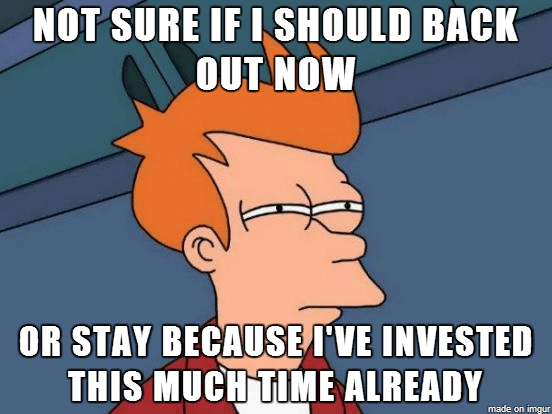Thanks for coming back to the Foundr series on entrepreneurial crossroads decisions, where we break down those potentially life-changing moments you’re sure to encounter and give you the facts to make the best choice for yourself. Be sure to check out Part 1 and Part 2 of this series if you haven’t already, otherwise just keep on reading!
A trademark quality of the entrepreneur is the ability make decisions. While not always right, a good entrepreneur is able to make decisions quickly and decisively, wasting no time on inaction and always looking forward.
If you’re afraid that doesn’t sound like you, though, don’t fret!
Truth be told, the ability to quickly make decisions is a learned skill—well that, or extreme stupidity. So don’t worry if find yourself um-ing and err-ing when faced with an entrepreneurial crossroads decision.
Get Your Checklist on When to Give It Up and When to Rise To Glory!
Even seasoned veterans of the startup game have to give pause when faced with a crossroads decision. These decisions aren’t easy, and it’s daunting when it feels like you need to make the “right” answer.
One thing you’ll quickly learn is that you will have to face these kinds of decisions at every stage of your career as an entrepreneur. Even after you’re somewhat established, as your startup scales you’ll encounter an entirely different kind of challenge as it goes through its growing pains.
So in order to help you along with these entrepreneurial crossroads decisions, here are three more classic decisions that every entrepreneur has to go through on their journey to success.
Do I shut it down?
One of the toughest decisions you’ll ever have to make as an entrepreneur is knowing when to call it quits.
Whether it’s a startup, a product you’ve built, or even a relationship you’ve developed, chances are you haven’t put that much thought into the worst-case scenario.
Let’s be clear here though, the worst-case scenario isn’t some spontaneous and large event that forces you to shut something down. If it were, this would be easy and it wouldn’t be a decision at all.
No, the worst-case scenario is the one where, despite the fact that you’ve invested so much time into something it’s still not working. It might be eking by, it might be enough to keep you afloat. But it’s not going anywhere, and all it’s doing is holding you back.
That’s the real worst-case scenario.
Those are the things that you need to get out of your life so you can focus on the most important stuff. But when you’ve spent years building something, watching it grow and working on it day-in and day-out it can be hard to let go.
There are numerous logical fallacies that do their best to make sure you’re stuck at this crossroads decision forever.
One of the most prevalent logical fallacies that entrepreneurs fall victim to is sunk-cost fallacy
Sunk-cost fallacy is a term that describes an investment that can never be recovered. As human beings, we hate feeling like our time or money has been wasted. As a result, we often become determined to ride out a bad decision despite the fact that objectively we’d be better off if we cut our losses.
When you’ve sunk a lot of time, resources, and energy into something, you can become determined to see some sort of return from it. Think about any time you’ve gotten a free ticket to a show you don’t like.
Despite knowing that you won’t enjoy the show and that you literally lose nothing by throwing the ticket away, you can’t help but feel like you should be getting a return on this ticket, otherwise it feels like you’re wasting something.
You’d get that feeling over a ticket to a show; can you imagine how much attachment you’d have to a project you’ve been there for since the beginning?
You’re essentially blinding yourself from the truth, meaning that you’ll ride out a bad decision because of the very brief signs of life that it’s working. So instead of doing the right thing and just cashing in your chips and walking away, you stay on because you just won a hand and you see it as a sign that you’re doing well.
Here’s what Adam Franklin of Bluewire Media shared with us about how he overcame this crossroads decision:
The toughest decision for Toby and me to make was to discontinue something we’d already invested time, money, and emotion into. However, cutting it off was the best thing for us.
We used to have a hosting product and a 300+ client list that was great “on paper.” It delivered recurring revenue, which was the part we grappled most with. But…there was a hidden cost that was quite debilitating and it took us a while to acknowledge. It was a drainer. So we debated letting it go.
When we were faced this tough decision the first two times, we stuck with hosting. We couldn’t let it go. The third time at this crossroad we made the very difficult decision to discontinue hosting, forego the recurring revenue and we referred our 300+ clients to another provider. It was a scary decision to sack hundreds of clients and stop a service offering, but it was very liberating as it freed up our team to focus on things that nourished us instead. We made up that “lost” revenue plus some by focusing on more rewarding work.
If only we’d done it sooner!
It’s never easy to pull the plug on something, especially if it’s something that you’ve poured your heart and soul into. But the reality is that as an entrepreneur you don’t have the time, resources or energy to waste on a bad decision. Especially when there’s a much better way for you to be spending your time.
Sunk-cost fallacy works off our subconscious desire to prevent losses instead of making gains. But once you flip the switch and start seeing the problem in light of the gains you could make, the question of whether to shut it down becomes a whole lot clearer. As Yaro Starak, founder of Entrepreneur’s Journey told us:
One of my toughest decisions as an entrepreneur was to shut down the startup I had worked on for two years with two co-founders.
Obviously a lot of factors went into the decision, but the one big reason we decided to close down was because we didn’t like where the company was heading. It started with a vision for a new socially driven advertising network for bloggers and brands, but over time the direction changed.
We reached a point where we had basically two options –
1) Bring on investors and dig in even deeper
2) Close down and move on
We had meetings with investors but in the end, we decided to close the business down. It was a decision made because we didn’t like the roles we would have to perform running the company, especially with the pressure to perform because of investors’ money being involved.
This experience taught me a lot about what kind of entrepreneur I am. I realized I’m more about lifestyle, and the thought of spending 12-hour days in my company was not appealing. I’ve always believed that your company should support your lifestyle, not define it. This experience with the advertising startup really brought this into clarity for me.
It can be very hard to look at something like this objectively. It’s even harder to admit that things might not have gone the way you planned and that it’s time to hang up the gloves.
Get Your Checklist on When to Give It Up and When to Rise To Glory!
The trick isn’t to look back and think of all the time wasted, but to take stock of all the things you learned and how you’re open for your next adventure now that you’ve finished with your last one.
Should I start diversifying?
As an entrepreneur, you’re probably a restless person—someone motivated by the desire to do something different than the rest of the crowd, to do more.
It’s that desire that allows entrepreneurs to push the boundaries of what’s allowed, seize new opportunities, and think outside the box. At the same time, it’s that desire that leads many entrepreneurs to accidentally bite off more that they can chew.
You’ll usually reach this crossroads decision when your startup is starting to do well and you begin to feel something that all entrepreneurs hate. You start to feel bored.
Much like a cat, entrepreneurs are attracted to shiny objects.
We can’t help it. Once we see something that could be the next big thing, the blinders turn on and that’s all we can see. We call this shiny object syndrome, and it could very well be holding you back.
In the blind rush to get that shiny red dot, we forget about everything else, which is why so many people rush through this crossroads decision without taking the time to pause and think about it.
Our good friend Natalie Sisson, founder of Suitcase Entrepreneur, recounts her story of what happened when she found herself getting overzealous and, as a result, overextended.
My toughest decision was in 2011 in Buenos Aires. I’d had my “business” since April the year before, but by business I mean blog and a community I was focused on growing with no email list or offerings. Then after successfully bringing in revenue in September through three physical workshops teaching entrepreneurs how to get business from social media, then launching it as an online program, I took off to Argentina to test my theory of being able to work from anywhere.
In hindsight, it might have been too soon. It was pretty stressful landing during my launch, trying to find an apartment to live in, decent internet, and trying to relearn the language I thought I knew (Spanish in Argentina sounds totally different).
Plus the launch wasn’t massively successful initially. Despite pouring my heart and soul into it, I remember flinging myself on my studio apartment bed claiming to be a total failure and not cut out for being an entrepreneur. I was financially strapped and totally miserable that I hadn’t achieved my goals.
Luckily, later that day I got perspective. Looked at the bigger picture of what I had achieved so far and focused on the solid foundations I had to build on.
You see this all the time with young entrepreneurs who are just starting out. Instead of focusing on building a solid strategy, they get way too excited by trying to incorporate the latest tactics.
Strategy is all about planning for the future and figuring how you’ll get to the outcome you want. Tactics are the actions and steps you take in order to get to your desired outcome.
“Strategic is doing the right things—tactical is doing things right.”
Think of it as wanting to build a car with all the latest features and gadgets but without the engine. Sure you have something that has GPS tracking, a surround sound system, and power everything, but what you don’t have is a car. Strategy is your engine and what’s going to get you to where you want to go. Tactics are the extra tools you use to help you get there quicker.
Why is it that we’re so focused on developing the leanest MVP possible without any added features, yet we fail to use that mentality with our own business strategy?
It’s only natural that as you start to scale you want to start diversifying your business. Add in some new features, or a new product to get it to the next level. The issue isn’t whether or not you should start diversifying your business, the issue is when you jump onto a new project prematurely.
Here’s what John Lee Dumas of Entrepreneur on Fire had to say to us about how he navigates through this particular crossroads decision:
The toughest decision I made as an Entrepreneur was what to NOT focus on. There are so many great opportunities that you can quickly stretch yourself thin and before you know it, you’ve lost sight of what made you successful in the first place.
For years, people have been telling me I should create and host a “Fire Nation” Conference. I know it would be fun in the end, but the work and effort leading up to it would crush other successful areas in our biz. FOCUS. Follow One Course Until Success.
In rock-climbing there is the three points of contact rule, which stipulates that you need at least two hands and one foot, or two feet and one hand be completely stable before finding the next rock to grab onto. This means that you have to be secure before you can progress—a lesson many entrepreneurs will do well to learn.

It’s only natural to start incorporating new things when you’re growing as a startup. At Foundr we started off as a simple entrepreneurship magazine, but as we grew we realized we had to expand our offerings. So today we have a podcast and our first course on how to dominate Instagram!
We painstakingly devoted hours upon hours to make sure each new project was great before we released it. But our top priority was always making sure that we never sacrificed the quality of our pre-existing projects. Even now, we’re always looking to find different ways to improve what we have. It’s never set and forget with us.
In the future, we might do Foundr events, workshops, maybe even Foundr.tv, but until then we’re always making sure that our foundation is as stable as possible.
While it can suck being bored and it can seem exciting to delve into something new, always take a minute to pause and think about your decision. Really consider what it is you have to gain, not just in the short term but in the years to come.
While it’s important to grow, don’t even rush through such an important entrepreneurial decision.
Should I expand?
Not everyone becomes an entrepreneur for the same reason.
There are the lifestyle entrepreneurs who start a business for the freedom of being their own bosses. There are entrepreneurs who want to change the world and carve their name into the history books. Some are in it for the money, and others just want to follow their passion.
No matter what your reason for being an entrepreneur is, you will encounter this crossroads decision at some point in your career.
As your startup grows, you’re going to have to make the conscious choice of whether you want to take it to the next level—whether you even want to scale in the first place.
One one hand, scaling means exciting new opportunities for your startup. There are chances to further your reach, dramatically increase your profits, and diversify your products. On the other hand, it also means a lot more work, and your business potentially defining your life even more than it does now.
You can stay in your lane and keep on doing what you’re doing or switch over to the fast lane.
According to Michael Masterson’s excellent book Ready, Fire, Aim there are four distinct stages in the lifecycle of a startup. Understanding these stages can help us make sense of just what’s happening whenever you face a decision to expand or not.
Stage one is when you’re still finding the legs of your startup. We call this the infant stage. You’re probably making less than $1 million in revenue and your main focus is on selling enough product to keep your business alive.
This also serves as the validation stage for your business. At this level, your entire goal is to test whether or not you have a business idea or a business. You have to be testing constantly and your main priority is laying down a solid foundation.
If the results coming back aren’t looking all that positive, then perhaps it’s time to move onto the next idea.
Stage two is the childhood stage. This is when you’re no longer scraping by, and you’re making enough money to be turning a tidy profit. In order to advance to the next stage, you need to start becoming more innovative and start creating more products to sell. Most entrepreneurs never progress past this stage.
The reason is because this is a very comfortable stage for most entrepreneurs. The business is running relatively smoothly and you’ve finally got a handle on it. To expand further will mean losing the level of control you have now and inviting more uncertainty back into your life.
It’s perfectly normal to be satisfied with this level of growth and not want to scale even further. It all depends on what it is you want as an entrepreneur. If you’re happy with just a steady business and not too keen on taking on any more work, this is a very comfortable spot. However, for those with larger ambitions this stage may not be enough.
Stage three is when your startup starts feeling the strain of expanding, also known as the teenager phase. Your once-small business is now gaining steam and experiencing unprecedented growth, only for you to realize it’s also turning into a logistical nightmare and customers are starting to notice. Now you need to focus on relinquishing control and creating the right systems and protocols.
This stage is perhaps the most vulnerable your startup will ever be in the startup lifecycle. The decisions you make during this period will drastically impact the future of your company.
Like jumping over a ravine, unless you gauge the distance correctly you can end up falling and never getting back up.
Even seasoned veterans of the startup game find this stage to be the most uncomfortable. For one thing, it means taking a step back from the business to focus on the bigger things and hiring someone else to take over your role. This is something that most entrepreneurs will struggle with and why many never progress past the childhood stage. As Marty Parker, president and CEO at Waterston Human Capital explains to us:
Easily the toughest decision was to change my own role. From a hands on leader and chief doer to a chief leader and hands on coach—moving from doing to leading others who do and teaching, training, and coaching. It was the toughest because it requires change and a shift in behavior and for the leader to change when they have been successful doing what they do, this is difficult and requires risk. The outcome was a more empowered team, a desire for senior team members to want to be coached as they felt trusted and more empowered to succeed than ever.
The teenager stage will also be your startup at its most volatile. There will be arguments about what direction you should grow in, hiring and training new employees will become a top priority, and this is when it’ll feel like everyone is watching and waiting for you to fail.
Some startups will stay in this stage a bit longer than others, needing some more time to “find themselves.” Some might even decide to go back the way they came and scale back down to the childhood stage and stick to what they know.
While this may be confusing and, at times, highly frustrating it can also be the incredibly exciting and rewarding. As long as you stick to your core values and vision, focus on creating the right protocols and procedures, you’ll be able to safely navigate you way to the final stage.
The fourth and final stage is when your startup reaches adulthood. The business is running to the point where you might not even be needed at this point. Your main question now is trying to figure out what role you’ll play in your startup’s future.
When your startup reaches adulthood it means that, more or less, it’s figured everything out. It’s achieved, or well on it’s way to achieving, your vision of success and it might be time to implement your exit strategy. You might decide to sell, maybe step down, or just keep on working.
Unless of course you’re a very particular kind of entrepreneur with a very particular set of ambitious goals and want to expand even further. In that case, you just might be the next world-changer.
As you encounter every stage of this lifecycle you will have to face this crossroads decision. On the journey to success it’s inevitable. But just as everyone’s reason for being an entrepreneur is different, so is everyone’s definition of success.
How you move past these decisions depends on you and what it is you want to achieve.
Conclusion
Every now and then, life throws you curveballs. These moments can be unexpected, frustrating, and aggravating to the point where you’re just stuck there in the middle of the road wondering which way to go.
On your startup journey you will experience these moments more than most. You’ll be facing crossroads decisions at every stage of your life as an entrepreneur.
Sometimes you’ll make a wrong turn somewhere, but that’s okay. It just means that you know the way a little better now and you won’t make the same mistake again. After all, no one makes the right choices all the time.
Get Your Checklist on When to Give It Up and When to Rise To Glory!
Just know that you’re not alone in this journey. Every entrepreneur in the world is hitting the exact same milestones as you, and you can learn from each other’s experiences.
Hopefully I’ve been able to help you out with this article series, even if it’s just a little bit, so that when you confront these decisions you’ll have a slightly easier time.
And of course, we’ve always got each other for support and advice, Foundr family. So be sure to join the discussion and leave your thoughts and questions in the comments below!






















